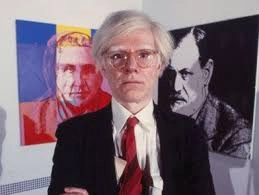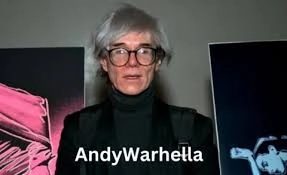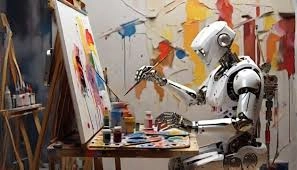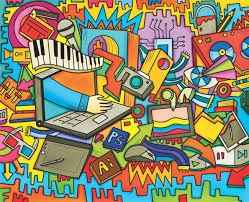Introduction
Understanding AndyWarhella: The fusion of classic art with modern artificial intelligence (AI) represents one of the most innovative intersections in contemporary creative practice. At the forefront of this movement is a fascinating entity known as “AndyWarhella,” a blend of technological ingenuity and artistic homage. Named after the iconic artist Andy Warhol, whose work revolutionized the world of pop art, AndyWarhella is reshaping how we perceive and create art. Combining classic art’s timeless aesthetics with cutting-edge AI technology makes this phenomenon more than just a novelty; it’s a significant shift in the landscape of art and culture.
What is AndyWarhella?
The Origins of AndyWarhella

AndyWarhella is not just an AI tool but a creative collaboration between human ingenuity and machine learning. Developed by a collective of artists, engineers, and data scientists, AndyWarhella seeks to extend the boundaries of what art can be. It was conceived as a digital artist that could synthesize the styles of classical and modern art, producing new works that resonate with the visual traditions of the past while exploring the possibilities of the future.
At its core, AndyWarhella utilizes advanced AI algorithms trained on vast datasets of historical art, including works from masters like Leonardo da Vinci, Vincent van Gogh, and, of course, Andy Warhol. By analyzing these artworks, the AI can learn their unique styles, brushstrokes, and color palettes. The result is a series of AI-generated images that not only mimic these classic styles but also introduce new, innovative elements that push the boundaries of traditional art.
The Role of AI in Art
AI’s role in art has evolved rapidly in recent years, moving from simple digital reproductions to the creation of entirely new works. Unlike traditional art forms where the artist’s hand is the primary tool, AI art relies on algorithms and neural networks to produce images. However, this doesn’t diminish the creativity involved. Instead, it introduces a new form of artistic collaboration, where the human artist acts as a curator or director, guiding the AI to produce desired outcomes.
In the case of AndyWarhella, AI serves as both a creator and a medium, capable of generating original art that aligns with the stylistic conventions of classic art while incorporating the unpredictability and innovation of machine learning. This dynamic interplay between humans and machines raises intriguing questions about the nature of creativity and the future of art in the digital age.
The Influence of Andy Warhol
Warhol’s Legacy in the Art World
To understand AndyWarhella, it’s essential to grasp the impact of Andy Warhol on the art world. Warhol was a pioneer of the pop art movement, which blurred the lines between high art and popular culture. His work, characterized by its bold colors and repetitive imagery, challenged the conventions of fine art and questioned the role of the artist in the modern world. Warhol’s fascination with mass production, consumer culture, and celebrity laid the groundwork for many of the themes explored in AI art today.
Warhol’s legacy is evident in the way AndyWarhella operates. Just as Warhol used mechanical reproduction techniques, like screen printing, to create his art, AndyWarhella used AI algorithms to produce his pieces. The digital nature of AndyWarhella’s work echoes Warhol’s experiments with technology, positioning it as a continuation of his artistic philosophy in the 21st century.
Pop Art and Technological Experimentation
Pop art was revolutionary in its embrace of technology and commercial imagery, and Warhol was at the forefront of this movement. His use of silkscreen printing allowed for the mass production of art, which democratized art ownership and challenged traditional notions of originality and authenticity. This approach to art-making is mirrored in AndyWarhella, where AI is used to create multiple iterations of an image, each with slight variations that reflect the input data.
Moreover, Warhol’s work often dealt with the relationship between humans and machines, a theme that is central to AndyWarhella. The AI’s ability to generate art that feels both familiar and novel is a testament to how technology can be harnessed to explore new artistic frontiers while still honoring the past.
The Marriage of Classic Art and AI
How Classic Art Styles Are Integrated
One of the most fascinating aspects of AndyWarhella is its ability to blend the styles of classic art with modern AI techniques. The process begins with the AI being trained on thousands of images of classic art, from Renaissance portraits to Impressionist landscapes. By analyzing these images, the AI learns to recognize the distinct features that define each style, such as the use of light in Baroque paintings or the vibrant colors of Fauvism.
Once the AI has absorbed these stylistic elements, it can apply them to new works, creating images that are both a tribute to and a reimagining of classic art. For instance, an AndyWarhella piece might take the delicate brushstrokes of a Van Gogh painting and apply them to a modern urban scene, creating a unique fusion of past and present. This ability to synthesize different artistic traditions is one of AndyWarhella’s most powerful features, allowing it to create works that feel timeless yet contemporary.
AI’s Role in Reinterpreting Historical Artworks
Beyond merely mimicking classic styles, AndyWarhella has the potential to reinterpret historical artworks in new and exciting ways. By deconstructing the elements of a classic painting and reassembling them through the lens of AI, AndyWarhella can create works that offer fresh perspectives on familiar subjects. This process not only highlights the adaptability of AI but also underscores the enduring relevance of classic art in the modern world.
For example, AndyWarhella might take a well-known painting like the Mona Lisa and reimagine it with a futuristic twist, incorporating elements of digital art and surrealism. This reinterpretation challenges viewers to reconsider their relationship with art and question the boundaries between the old and the new.
The Technology Behind AndyWarhella

AI Algorithms and Deep Learning
At the heart of AndyWarhella’s creative process are advanced AI algorithms, particularly those involving deep learning. Deep learning, a subset of machine learning, involves training AI models on large amounts of data to recognize patterns and make decisions. In the case of AndyWarhella, deep learning allows the AI to analyze vast datasets of classic art, learning the intricate details of various artistic styles and techniques.
These algorithms are designed to identify the specific features that define a particular style, such as the way light interacts with objects in a painting or the color schemes that are characteristic of a certain period. Once the AI has learned these features, it can generate new images that adhere to the same stylistic conventions, producing works that are both aesthetically pleasing and historically informed.
Neural Networks and Artistic Creativity
Neural networks, another key component of AndyWarhella’s technology, play a crucial role in the AI’s ability to generate art. These networks are designed to mimic the way the human brain processes information, allowing the AI to “think” in a way that is similar to human cognition. This enables the AI to not only replicate existing art styles but also to innovate and create new ones.
The use of neural networks in art generation is particularly exciting because it opens up new possibilities for artistic creativity. By allowing AI to experiment with different combinations of styles and techniques, neural networks enable AndyWarhella to produce truly original works, pushing the boundaries of what is possible in art.
How AndyWarhella is Revolutionizing Art
Democratizing Art Creation
One of the most significant impacts of AndyWarhella is its potential to democratize art creation. Traditionally, creating art required a certain level of skill and training, as well as access to materials and resources. However, with the advent of AI tools like AndyWarhella, anyone can become an artist, regardless of their background or experience. This democratization of art is empowering a new generation of creators, who can use AI to express themselves in ways that were previously unimaginable.
AndyWarhella makes it possible for individuals who may not have formal art training to create works that are visually striking and conceptually rich. By removing the barriers to entry, AndyWarhella is opening up the world of art to a broader audience, encouraging more people to engage with and appreciate art.
Accessibility for Emerging Artists
For emerging artists, AndyWarhella offers a powerful tool for experimentation and exploration. The AI’s ability to generate art in a wide range of styles allows artists to explore different artistic traditions and find their unique voices. This accessibility is particularly important in today’s fast-paced digital world, where artists are constantly looking for new ways to stand out and make an impact.
Moreover, AndyWarhella’s digital nature makes it easy for artists to share their work with a global audience. Through online platforms and social media, artists can showcase their AI-generated art to a wider audience, gaining recognition and building their careers in ways that were previously difficult to achieve.
Criticism and Controversy
Ethical Dilemmas in AI-Generated Art
As with any new technology, the rise of AI-generated art has not been without its controversies. One of the most pressing ethical dilemmas surrounding AndyWarhella is the question of authorship. In traditional art, the artist is the sole creator of their work, but in the case of AI art, the lines between creator and creation are blurred. Who owns the rights to an AI-generated artwork? Is it the human who programmed the AI, the AI itself, or the person who commissions the work?
These questions have sparked intense debate in the art community, with some arguing that AI-generated art lacks the authenticity and emotional depth of human-made art. Others, however, see AI as a legitimate tool for artistic expression, one that can expand our understanding of what art can be.
The Debate Over Authenticity and Ownership
The issue of authenticity is closely tied to the question of ownership. In the traditional art world, an artwork’s value is often tied to its authenticity or the degree to which it is an original creation by the artist. However, with AI-generated art, this concept becomes more complex. Since AndyWarhella can produce multiple iterations of a single image, each with slight variations, it challenges the idea of a “one-of-a-kind” artwork.
This has led to debates over the value of AI art and whether it should be considered on par with traditional art forms. Some argue that the uniqueness of an artwork lies in its creation process, and since AI-generated art involves a different process than human-made art, it should be valued differently. Others believe that the creative potential of AI should be embraced and that AI-generated art can be just as valuable as traditional art.
Case Studies
AndyWarhella in Modern Galleries
Despite the controversies, AndyWarhella has found a place in modern galleries, where its works are often displayed alongside traditional art. These exhibitions provide a fascinating glimpse into the future of art, showcasing how AI can coexist with and complement classic art forms. Visitors to these galleries are often struck by the seamless blend of old and new, as AndyWarhella’s works evoke the past while pushing the boundaries of what art can be in the digital age.
One notable example is an exhibition at a leading contemporary art gallery, where AndyWarhella’s AI-generated pieces were displayed alongside works by human artists. The exhibition attracted widespread attention, with many praising the innovative use of technology in art and the thought-provoking nature of the works. This demonstrates the growing acceptance of AI art in the mainstream art world and its potential to shape the future of artistic expression.
Collaboration with Contemporary Artists
AndyWarhella has also inspired collaborations with contemporary artists, who see AI as a tool for expanding their creative horizons. By working with AndyWarhella, artists can experiment with new styles and techniques, exploring ideas that would be difficult or impossible to achieve through traditional methods. These collaborations often result in works that are both visually stunning and conceptually rich, highlighting the potential of AI as a creative partner.
For example, a recent collaboration between AndyWarhella and a well-known digital artist resulted in a series of works that combined the artist’s unique style with the AI’s ability to generate complex patterns and textures. The resulting pieces were celebrated for their innovation and artistic merit, demonstrating the potential of AI to enhance and inspire human creativity.
The Future of Art in the Age of AI

Predicting the Evolution of AI Art
As AI continues to evolve, so too will its role in the art world. The future of AI art is likely to be marked by even greater collaboration between humans and machines, as artists explore new ways to integrate AI into their creative processes. We can expect to see more sophisticated AI tools that can generate increasingly complex and nuanced artworks, pushing the boundaries of what is possible in art.
In addition to creating new works, AI will also play a role in preserving and analyzing existing artworks. AI algorithms can be used to study art history, uncovering hidden patterns and trends that were previously unknown. This could lead to new insights into the development of art over time and help us better understand the cultural and historical significance of different artistic movements.
The Role of Artists in an AI-Driven World
While AI will undoubtedly play a significant role in the future of art, human artists will remain central to the creative process. The relationship between artists and AI will be one of collaboration, with AI serving as a tool that enhances and extends human creativity. Artists will continue to bring their unique perspectives and experiences to their work, using AI to explore new ideas and push the boundaries of their art.
As AI becomes more integrated into the art world, artists will need to navigate the ethical and practical challenges that come with this new technology. This will require a deep understanding of both the potential and the limitations of AI, as well as a commitment to maintaining the integrity and authenticity of their work. In this way, artists will help shape the future of art in an AI-driven world, ensuring that creativity and human expression remain at the heart of the artistic process.
Understanding AndyWarhella: The Artistic Process
How AI Mimics Human Creativity
One of the most intriguing aspects of AndyWarhella is how it mimics human creativity. While AI lacks the emotions and experiences that drive human artists, it can analyze vast amounts of data to identify patterns and generate new ideas. This process is similar to how human artists draw inspiration from their surroundings, incorporating elements of the world around them into their work.
However, unlike human creativity, which is often spontaneous and intuitive, AI creativity is based on algorithms and data analysis. This means that while AndyWarhella can produce art that is visually similar to human-created works, it does so through a fundamentally different process. Understanding this distinction is key to appreciating the unique nature of AI art and its place in the broader art world.
The Role of Human Curation in AI Art
Despite the advanced capabilities of AI, human curation remains an essential part of the AndyWarhella process. While the AI can generate a wide range of images, it is up to the human curator to select the most compelling works and present them in a way that resonates with viewers. This collaborative process ensures that the final artworks are not only technically impressive but also emotionally and intellectually engaging.
Human curators also play a crucial role in guiding the AI, providing feedback and input that helps refine the algorithms and improve the quality of the generated art. This ongoing interaction between humans and machines is what makes AndyWarhella’s work so dynamic and innovative, blending the best of both worlds to create something truly unique.
The Impact on Traditional Art Forms
How AndyWarhella Challenges Traditional Art
The emergence of AndyWarhella has sparked a reevaluation of traditional art forms, challenging long-held assumptions about what art is and how it should be created. By demonstrating that machines can produce art that is both aesthetically pleasing and conceptually rich, AndyWarhella has forced the art world to confront the possibilities and limitations of technology in artistic creation.
This has led to a renewed interest in creativity and the role of the artist in the digital age. Some traditional artists see AndyWarhella as a threat, fearing that AI could replace human creativity and diminish the value of their work. Others, however, view it as an opportunity to explore new artistic frontiers and expand the boundaries of their practice.
The Response from Traditional Art Institutions
Traditional art institutions have responded to AndyWarhella with a mix of curiosity and caution. While some galleries and museums have embraced AI art, incorporating it into their exhibitions and collections, others remain skeptical of its artistic merit. This divide reflects broader debates within the art world about the value of technology in art and the future of artistic creation.
As AI art continues to gain traction, traditional art institutions will need to find ways to engage with this new form of artistic expression. This may involve rethinking their approach to curation, education, and audience engagement, as well as developing new frameworks for evaluating and appreciating AI-generated art.
Consumer Experience with AndyWarhella
How Art Lovers Interact with AI-Generated Art
For art lovers, AndyWarhella offers a new and exciting way to engage with art. The interactive nature of AI-generated art allows viewers to explore different interpretations and variations of a single image, deepening their understanding of the creative process. This interactivity is particularly appealing to younger audiences, who are accustomed to digital and interactive media.
Moreover, the digital nature of AndyWarhella’s work makes it easily accessible to a global audience. Art lovers can view and purchase AI-generated art online, without the need to visit a physical gallery. This accessibility has the potential to broaden the reach of art and make it more inclusive, allowing more people to experience and appreciate artistic creation.
The Market for AI-Generated Art
The market for AI-generated art is still in its early stages, but it is growing rapidly. As more people become aware of the possibilities of AI art, demand for these works is likely to increase. This presents new opportunities for collectors and investors, who may see AI art as a promising and innovative addition to their portfolios.
However, the market for AI art also raises important questions about value and authenticity. Because AI can generate multiple versions of a single image, the traditional concept of a “one-of-a-kind” artwork is challenged. This may require new approaches to pricing and selling AI-generated art, as well as new ways of assessing its value.
Legal Implications and Copyright Issues
Copyright in the World of AI Art
One of the most complex issues surrounding AndyWarhella is copyright. Traditional copyright laws were designed to protect the intellectual property of human creators, but they do not easily apply to works generated by AI. This has led to debates over who owns the rights to AI-generated art and how these rights should be enforced.
Some argue that the creators of the AI, or the individuals who train and guide the algorithms, should hold the copyright to the works produced. Others believe that AI-generated art should be considered a public domain, free for anyone to use and reproduce. As AI art becomes more prevalent, it will be crucial to develop new legal frameworks that address these issues and protect the rights of all parties involved.
Protecting Artists’ Rights in the Digital Age
In addition to copyright, there are broader concerns about protecting artists’ rights in the digital age. As AI becomes more capable of producing high-quality art, there is a risk that human artists could be marginalized or displaced. To address this, it is important to ensure that artists are fairly compensated for their work and that their contributions are recognized and valued.
This may involve developing new business models that allow artists to collaborate with AI, sharing in the profits and creative control of the works produced. It may also require new legal protections that ensure artists’ rights are upheld in an increasingly digital and automated world.
AndyWarhella in Education
Teaching Art in a Digital World

AndyWarhella has significant implications for art education, offering new tools and techniques for teaching art in a digital world. By incorporating AI into the classroom, educators can introduce students to new ways of thinking about creativity and artistic expression. This can help students develop a deeper understanding of the creative process and inspire them to explore new artistic possibilities.
Moreover, AndyWarhella can be used to teach students about the history of art, as the AI’s ability to mimic classic styles provides a valuable tool for studying different artistic traditions. By analyzing AI-generated art, students can gain insights into the techniques and approaches used by historical artists, deepening their appreciation of art history.
The Role of AI in Art Education
AI also has the potential to play a broader role in art education, helping to democratize access to artistic training and resources. Educators can level the playing field by providing students with tools like AndyWarhella, allowing more students to explore their creativity and develop their artistic skills.
This is particularly important in a world where geography, resources, and socioeconomic factors often limit access to traditional art education. By harnessing the power of AI, educators can make art education more accessible and inclusive, empowering the next generation of artists to reach their full potential.
Conclusion
The Lasting Impact of AndyWarhella
AndyWarhella represents a bold and exciting step forward in the evolution of art. By blending classic art with modern AI, it challenges our preconceptions about creativity, authenticity, and the role of technology in artistic expression. While it raises important questions and controversies, it also opens up new possibilities for artists, curators, and art lovers alike. For more information please get in touch